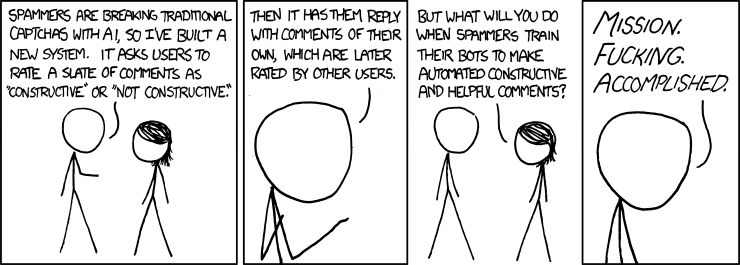gonna be the future soon
Remember this XKCD?
I am staring at Mission. Fucking. Accomplished. in my spam queue right now. In response to my post last week about studio monitors and the importance of flat frequency response curves:
The text:
Why have I included a frequency-response curve here? I mentioned earlier that the frequency-response curves in a sales brochure are typically meaningless in terms of providing information that’s useful to an end user. Actually, though, I’d go further than that, and suggest that in many respects making any judgment about the worth or likely value of a monitor by examining its frequency-response curve is not far short of pointless. I often read opinions on the SOS Forum arguing that to be of any value monitors require a ‘flat frequency response’, but numerous recordings made during what many would consider the golden age for musical sound quality (the ’60s and ’70s) were monitored on speakers that were all over the place in terms of frequency response — and I don’t know why recording engineers seem to believe so strongly that a monitor should be anechoically ‘flat’ when so much end-product evidence suggests that this isn’t particularly important.
Constructive. Relevant. Interesting. Starts an argument. And the blocked-out information reveals it to be a spambot.
I kind of want to approve it! I’m not. I’m going one further: elevation to top of post, and addressing the spambot’s point, since it had one. Congratulations, spambot, well done: you’ve earned it.
My response, I suppose, would be that the nonflat monitor speakers of the time were reasonably accurate representations of average home speakers, which were nowhere near flat either.
And once you got into the era of flat response curves being achieved, followed by an era of goosing-by-design (rather than nonflat-by-technological limitations), it became necessary to move to a neutral reference base for studios. Simply put, you can’t try to guess all the many ways that people intentionally-off-flat-response systems, so don’t try to optimise for any of them; optimise instead for the average of all of those systems.
I’d also argue that the late 60s weren’t my idea of a golden era of recording. There are some fantastic jazz and classical recordings from the era, absolutely, but a lot of rock and pop was still very fuzzy and often kind of muddled. To my ear, recording continued to improve up until the Loudness Wars – with a hiccough as everyone learned to deal with digital equipment – and that’s fashion, not technology.
So that’s why I still argue that in the current era going for flat – or reasonably close to it – is the best idea.
Your move, spambot. I’ll be checking the queue.
it’s not your fault… or is it?
Mirrored from Crime and the Blog of Evil. Come listen to our music!









